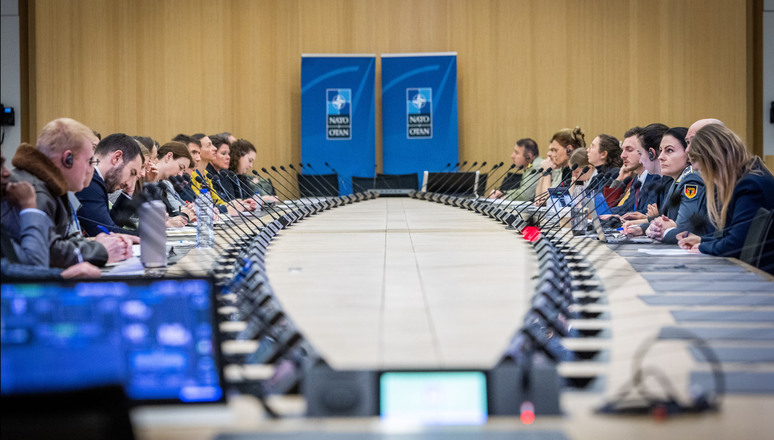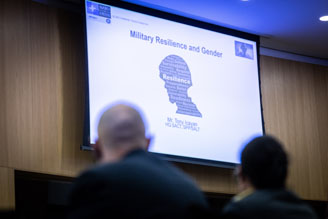On the 15th November 2022, the NATO International Military Staff (IMS) GENAD Office hosted its monthly Deep Dive Session, this time focused on the relationship between resilience and the Gender Perspective. This session explored the crucial role of integrating Gender Perspective for strengthening national and collective resilience to support NATO in safeguarding its nations, societies and shared values.

Subject matter expertise was provided by Mr. Damiano Rinauro, Defence Policy and Planning (DPP) Division at NATO HQ, Mr. Anthony Icayan, Military Resilience Analyst and Gender Focal Point (GFP) at NATO ACT, Ms. Gergana Vaklinova, GENAD at the Crisis Management and Disaster Response Centre of Excellence (CMDR COE) and Dr. Jocelyn Kelly, Director for the Program on Gender, Rights and Resilience (GR2) at the Harvard Humanitarian Initiative (HHI).
Resilience at NATO
First speaker Mr. Rinauro provided an overview of how resilience is situated within NATO’s approach to civil preparedness, highlighting the significance of resilience in an unpredictable security environment. He further explained that resilience is the first line of defence, functioning as a deterrence to an adversary and enabling NATO to absorb and recover from strategic shocks. Mr. Rinauro then proceeded to outline NATO’s seven baseline Requirements of Resilience.
He explained the purpose of the baselines to provide benchmarks for allies to support the Alliance, and how these benchmarks are designed to interact with each other. Mr. Rinauro highlighted the need for adaptive coordination between civil society and the military for a whole-of-society approach to strengthen the baseline requirements, including the use of gender disaggregated data.
Military Resilience

Building upon Mr. Rinauro’s inputs, Mr. Icayan explained the interdependencies between civil and military resilience. He explained the role of NATO’s Military Instrument of Power: to build resilience in order to anticipate, prepare for, and adapt to threats and hazards, and to withstand, respond and recover from strategic shocks. Mr. Icayan outlined the seven thematic areas that illustrate the Military Instrument of Power as a C2 system with a focus on situational understanding, warfighting capabilities, logistics, response planning, perseverance, and military infrastructure.
Mr. Icayan then proceeded to discuss how integrating the Gender Perspective in these thematic areas serves to strengthen overall resilience, focusing specifically on building situational awareness and perseverance. Mr. Icayan explained how the use of gender-disaggregated data and the application of the Gender Perspective improve situational awareness and understanding for the cognitive domain. Lastly, he explained the need to understand human security dimensions and the different perspectives of women, men, boys and girls to build perseverance towards developing individual resilience. Developing individual resilience enables greater societal resilience, allowing NATO to draw on all elements of society for a more effective crisis response and management.
A 360 Degree Approach to Resilience

Ms. Vaklinova discussed the way to build a 360 degree approach including the Gender Perspective for security and resilience to navigate uncertainty and accentuate understanding of risks and threats. She explained how resilience and gender are both complex and transformational concepts that necessitate a collaborative multidisciplinary approach to bring about positive and long-term outcomes for peace and security. Ms. Vaklinova further explained that, because militaries are reflective of their societies and because society is a complex system with gendered relations, ensuring agency and empowerment for people in resilience planning by integrating a Gender Perspective is crucial.
Ms. Vaklinova expanded on the concept of resilience beyond civil and military components, noting other efforts and challenges in resilience, such as risk perception levels and how different genders may perceive and understand risk differently. She discussed how the intersection of gender and resilience offers opportunities for bridging understandings and creating necessary synergies across fields and functions. Understanding the different risk perception and risk acceptance levels of the different genders can improve our understanding of what drives conflicts and in turn how conflict generates differentiated impacts for women, men, boys and girls. At the same time, strengthening resilience is instrumental to fostering gender equality and ensuring that social inequalities are not reinforced. Finally, Ms. Vaklinova highlighted the importance of gender training, Gender Focal Points and Gender Advisors to reinforce resilience. To learn more about Resilience or Gender Perspective trainings from the CMDR COE, please click here.
Human Security, Gender and Resilience
Dr. Kelly discussed the crucial relationship of gender with the state and human security, and how incorporating a gendered lens leads to stronger and more resilient societies and improved early warning systems, including aspects of atrocity prevention and peace building. She demonstrated the significant relationship between the physical security of women and the peacefulness of states, highlighting how women’s security is a better indicator of state stability than the level of democracy or per capita GDP. Dr. Kelly further examined how women’s experiences and perceptions should be utilized as a resource in resilience building, due to their unique understanding of harms and early warning signs of conflict. Thus, integrating a gender-sensitive analysis into early warning systems can contribute to conflict prevention and improve societal resilience.
Dr. Kelly continued to explore the relationship between gender, human security and resilience by discussing how insecurity and increasing community violence have different impacts on women, men, boys and girls, with an often particularly negative impact on women and other vulnerable groups. She discussed how conflict related sexual violence (CRSV), as an example, has consequences on individuals, communities and global security, resulting in long-term cycles of violence that undermine peace and resilience. Dr. Kelly discussed how gender-based violence (GBV) is used in political conflicts, and how GBV and CRSV continue to be prevalent in post-conflict settings by moving into the less visible private sphere , thus hindering post-conflict recovery.
Lastly, Dr. Kelly explained how to measure and assess the concept of resilience through sharing outcomes from her research on the Northern Democratic Republic of the Congo. Her research pointed to a number of validated and project-specific measures that were combined into an all-resilience score. These measures included in-group and out-group attitudes, measures of self-efficacy, measures of individual resilience, and measures of community resilience. Her findings demonstrated that those higher all-resilience scores were far more likely to express tolerant attitudes towards people from different tribes and ethnicities.
In summary, enhancing resilience requires a whole-of-society approach that necessitates integrating the Gender Perspective to better understand drivers of conflict. This understanding will support NATO to anticipate and adapt to threats, and to withstand, respond to and recover rapidly from strategic shocks.
